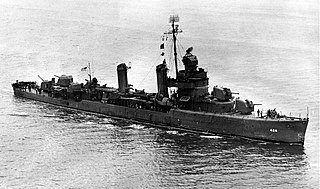
USS Cole (DD-155) was a Wickes-class destroyer in the United States Navy during World War II, later reclassified as AG-116. It was named for Edward B. Cole, a United States Marine Corps officer who died as a result of the wounds he received at the Battle of Belleau Wood.

USS Dickerson (DD-157) was a Wickes-class destroyer in the United States Navy, and was converted to a high-speed transport at Charleston, South Carolina and designated APD-21 in 1943. She was named for Mahlon Dickerson (1770–1853), Secretary of the Navy from 1834 to 1838.

USS Leary (DD-158) was a Wickes-class destroyer in the United States Navy during World War II. She was named for Lieutenant Clarence F. Leary, posthumously awarded the Navy Cross in World War I.

USS Schenck (DD-159) was a Wickes-class destroyer in the United States Navy during World War II. She was named for Rear Admiral James F. Schenck, USN (1807–1882).

USS Herbert (DD-160) was a Wickes-class destroyer. She was named for Hilary A. Herbert (1834–1919), Secretary of the Navy from 1893 to 1897.

USS Babbitt (DD–128) was a Wickes-class destroyer in the United States Navy during World War I and World War II, later classified as AG-102. She was named for Fitz Babbitt.

USS Upshur (DD–144) was a Wickes-class destroyer in the United States Navy before and during World War II. She was the first ship named for Rear Admiral John Henry Upshur.

USS Breckinridge (DD–148) was a Wickes-class destroyer in the United States Navy during World War II, later reclassified as AG-112. She was named for Ensign Joseph Breckinridge.

USS Du Pont (DD–152) was a Wickes-class destroyer in the United States Navy during World War II, later reclassified as AG-80. She was the second ship named for Rear Admiral Samuel Francis Du Pont.

USS Bernadou (DD–153) was a Wickes-class destroyer in the United States Navy during World War II. She was named for Commander John Bernadou. Bernadou was launched on 7 November 1918 by William Cramp & Sons Ship and Engine Building Company, Philadelphia. The ship was sponsored by Miss Cora Winslow Bernadou, Commander Bernadou's sister. The destroyer was commissioned on 19 May 1919, Lieutenant Commander L. G. Farley in command.

USS Ellis (DD–154) was a Wickes-class destroyer in the United States Navy during World War II. She was reclassified AG-115 on 30 June 1945. She was named for Chief Yeoman George Henry Ellis.

USS MacLeish (DD-220/AG-87) was a Clemson-class destroyer in the United States Navy during World War II. She was named for Lieutenant Kenneth MacLeish.

USS Simpson (DD-221/APD-27/AG-97) was a Clemson-class destroyer in the United States Navy during World War II. She was the first ship named for Rear Admiral Edward Simpson.

USS McCormick (DD-223/AG-118) was a Clemson-class destroyer in the United States Navy during World War II. She was named for Lieutenant, junior grade Alexander McCormick, Jr.

USS Edison (DD-439), a Gleaves-class destroyer, was the first ship of the United States Navy to be named for Thomas Alva Edison, an inventor and businessman who developed many important devices and received the Navy Distinguished Service Medal for his contributions to the Navy during World War I. Edison was one of the few U.S. Navy ships to be named for a civilian.

USS Eberle (DD-430) was a Gleaves-class destroyer of the United States Navy. The ship is named for Rear Admiral Edward Walter Eberle, who commanded the Atlantic and Pacific Fleets and was Chief of Naval Operations from 1923 to 1927. The destroyer entered service in 1940 and spent the majority of her career in the Atlantic Ocean. Placed in reserve following the war, the ship was transferred to the Hellenic Navy in 1951. Renamed Niki, the destroyer remained in service until 1972 when she was scrapped.

The third USS Decatur (DD-341) was a Clemson-class destroyer in the United States Navy following World War I. She was named for Stephen Decatur.

USS Benson (DD-421) was the lead ship of her class of destroyers in the United States Navy during World War II. She was named for Admiral William S. Benson (1855–1932).

USS Hilary P. Jones (DD-427) was a Benson-class destroyer in the United States Navy during World War II. She was named for Admiral Hilary P. Jones.

USS Charles F. Hughes (DD-428) was a Benson-class destroyer in the United States Navy during World War II. She was named for Charles Frederick Hughes.




















